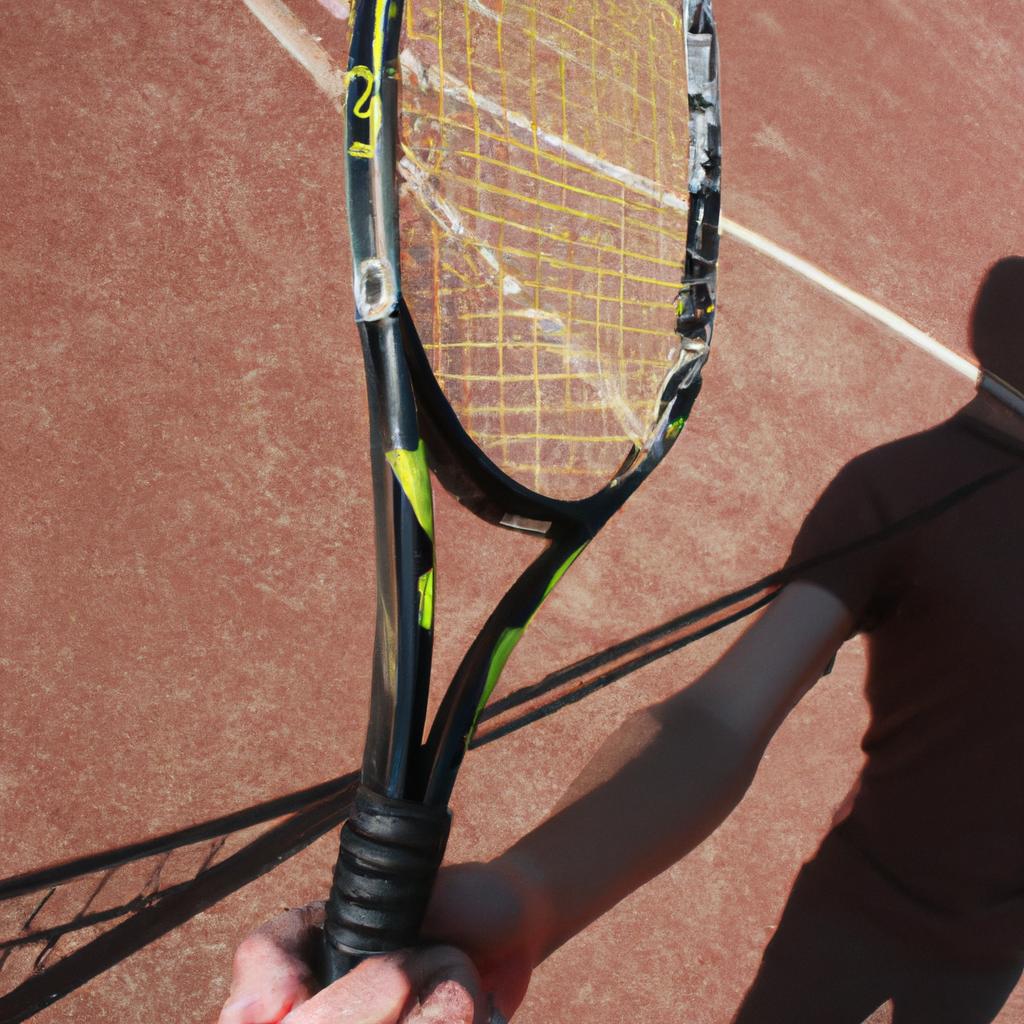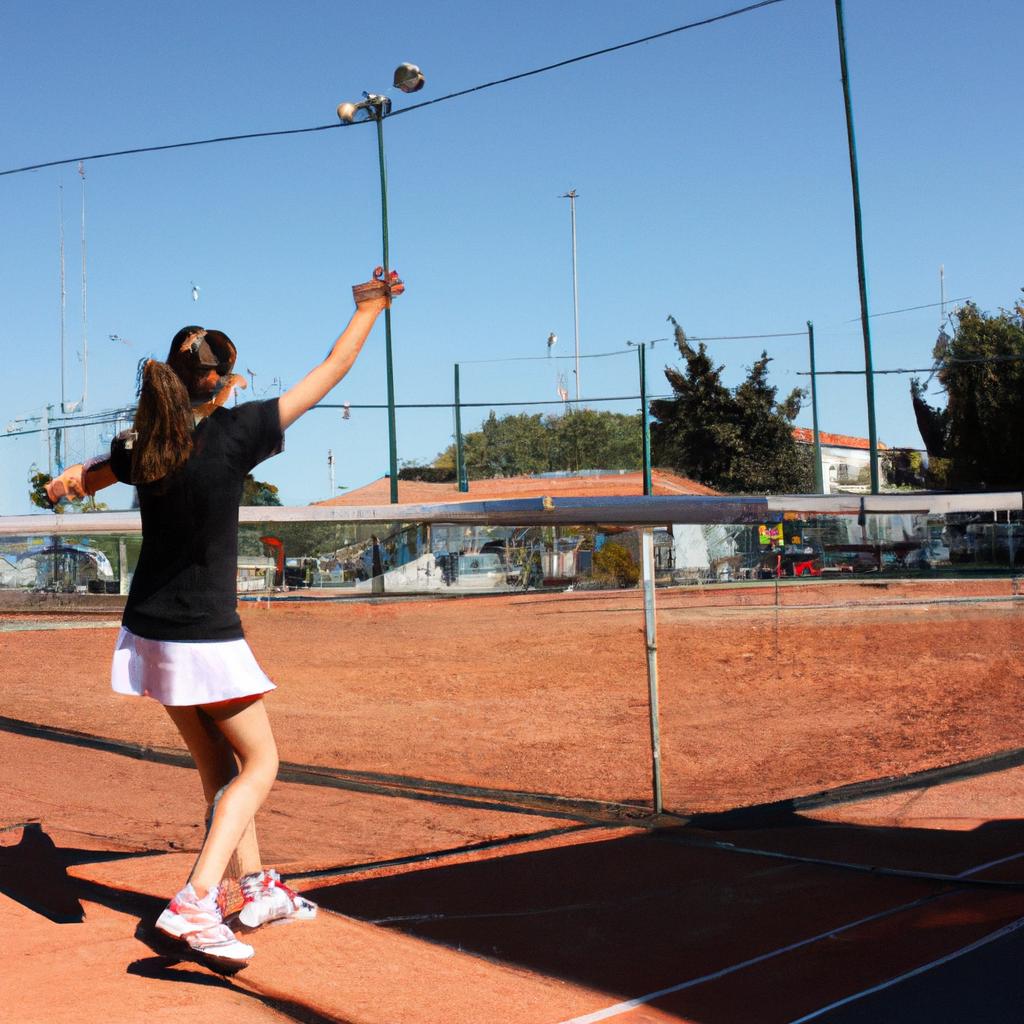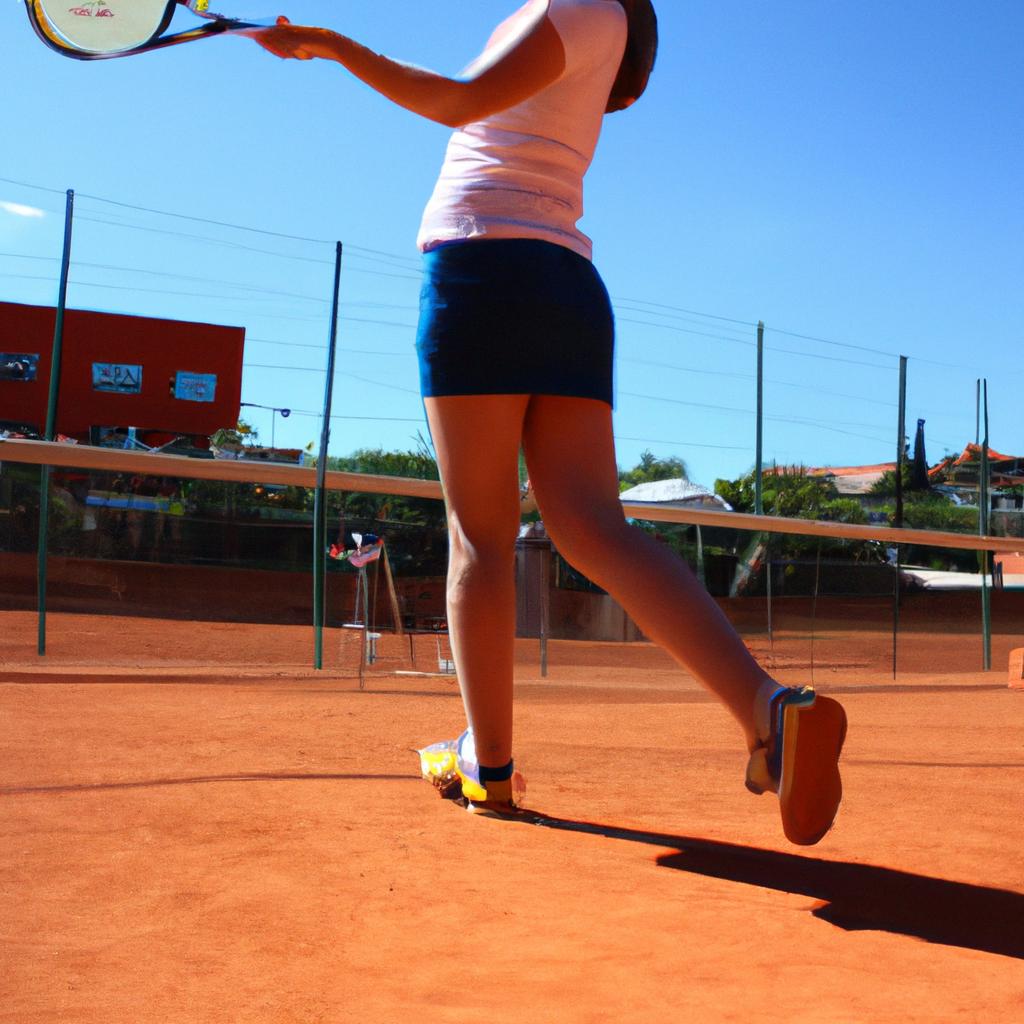Tennis, a sport that dates back to the 19th century, is characterized by its fast-paced action and strategic gameplay. Whether you are new to the game or looking to brush up on your skills, understanding tennis rules and regulations is essential for participating in this exhilarating sport. In this article, we will provide a comprehensive guide specifically tailored for Swim & Tennis Club tennis lessons. By exploring key aspects such as scoring systems, court dimensions, and code of conduct, this guide aims to equip players with the necessary knowledge to engage in fair and enjoyable matches.
Imagine a scenario where two enthusiastic beginners step onto a tennis court for their first lesson at a local Swim & Tennis Club. Excitement fills the air as they grip their rackets and eagerly await their instructor’s guidance. However, without an understanding of the basic tennis rules and regulations, their experience may quickly become confusing and frustrating. To prevent such scenarios from occurring, it is crucial for both novice players and seasoned athletes alike to familiarize themselves with the fundamental guidelines governing the game. This article seeks to demystify these rules, providing clarity and insight into various aspects of tennis etiquette and gameplay mechanics.
The Court: Dimensions and Lines
Imagine stepping onto a tennis court for the first time. As you survey the surroundings, you notice the precisely measured dimensions and lines that define the playing area. These components are not merely aesthetic; they serve crucial purposes in ensuring fair and enjoyable gameplay.
The standard tennis court is rectangular, measuring 78 feet (23.77 meters) long and 27 feet (8.23 meters) wide for singles matches, while doubles matches require an additional width of 4.5 feet (1.37 meters) on each side. This distinction emphasizes the importance of strategy and teamwork in doubles play, as players must cover more ground to outmaneuver their opponents effectively.
To provide clear boundaries during a match, white lines mark the perimeter of the court. The outermost line signifies the baseline at the back of each player’s side, while two parallel sidelines delineate the sides of the court. Within these margins lie two pairs of service boxes along with a center service line dividing them symmetrically.
Now let us explore some key aspects of the tennis court:
- Baseline: The boundary farthest from the net where players begin each point.
- Sidelines: They run parallel to each other, defining the lateral extent of play.
- Service Boxes: Rectangular areas located diagonally across from one another within which serves must land.
- Center Service Line: It divides both sets of service boxes and determines whether serves are directed into either box on either half of the court.
By understanding these elements, players gain a deeper appreciation for tennis’s precision and tactical nature—the finesse required to hit shots within certain parameters or exploit opponents’ weaknesses becomes evident when considering how every inch can influence outcomes.
As we delve further into learning about tennis rules and regulations, our next section will discuss scoring—how points accumulate through “Love,” “Fifteen,” “Thirty,” “Forty,” “Deuce,” “Advantage,” and ultimately lead to winning a game. Understanding the scoring system is essential in comprehending the ebb and flow of a match, making it easier to appreciate players’ strategies as they navigate their way towards victory.
Now that we have explored the court’s dimensions and lines, let us transition into our next section about scoring without missing a beat.
Scoring: Love, Fifteen, Thirty, Forty, Deuce, Advantage, Game
Imagine you are participating in a tennis match at your local swim and tennis club. As you step onto the court, you notice how the atmosphere is filled with excitement and anticipation. The players around you seem focused, ready to showcase their skills while adhering to important rules of respect and sportsmanship. Understanding proper court etiquette not only enhances the overall playing experience but also fosters a positive environment for everyone involved.
One key aspect of court etiquette is maintaining silence during play. This ensures that players can concentrate on their strategies without distractions. Imagine if one player were constantly talking or making unnecessary noise; it would disrupt the flow of the game, causing frustration for both players and spectators alike.
To further promote fair play and camaraderie, here are some guidelines to follow:
- Always acknowledge good shots from your opponent by applauding or offering a simple nod.
- Avoid arguing with officials or questioning line calls excessively.
- Maintain composure even when faced with challenging situations.
- Extend congratulations to your opponent after each match, regardless of the outcome.
By adhering to these principles, players establish an atmosphere where respect and sportsmanship thrive, creating an enjoyable experience for all involved.
| Respectful Actions | Impact |
|---|---|
| Applauding good shots | Fosters positivity |
| Avoiding excessive arguments | Promotes fair play |
| Maintaining composure | Enhances focus |
| Offering congratulations | Builds camaraderie |
In conclusion, understanding and practicing proper court etiquette is crucial in ensuring a respectful and enjoyable tennis experience for all participants. By embracing this code of conduct, players contribute towards cultivating an environment that values fairness, courtesy, and cooperation. With such qualities established on the court, it becomes easier to appreciate the skillset required in serving techniques and faults – our next topic of discussion.
As we explore the nuances of serving techniques and faults, let us delve deeper into this essential aspect of tennis gameplay.
Serving: Techniques and Faults
Moving on to another crucial aspect of tennis, let us now delve into serving techniques and faults. By understanding the correct methods for executing a serve and being aware of common mistakes that can be made, players can enhance their performance on the court.
To illustrate the significance of proper serving techniques, consider this hypothetical scenario: Emma is an aspiring tennis player who has been struggling with her serves during matches. She often finds herself committing faults or failing to achieve optimal power in her shots. Understanding the importance of serving techniques will enable Emma to rectify these issues and improve her overall game.
When it comes to serving, there are several key points to keep in mind:
- Grip: The grip plays a fundamental role in achieving accuracy and power in your serve. Opting for a continental grip allows for versatility between different types of serves.
- Stance: A balanced stance forms the foundation for a strong serve. Placing your feet shoulder-width apart and positioning yourself sideways towards the net ensures stability throughout your motion.
- Ball toss: Consistency in ball placement is essential when tossing before serving. Aim for a high toss slightly above your hitting arm’s highest point to allow ample time for preparation.
- Follow-through: The follow-through phase should not be neglected as it contributes significantly to shot control. Emphasize extending your arm forward and finishing with a smooth swing across your body.
By adhering to these guidelines, players like Emma can avoid common serving faults such as foot faults, double faults (two consecutive service errors), or hitting outside the imaginary box designated by the lines on each side of the court.
| Common Serving Faults | Causes | Impact |
|---|---|---|
| Foot faults | Incorrect foot placement | Loss of point/repeat serve |
| Double faults | Inconsistent ball toss | Loss of point/repeat serve |
| Hitting outside the box | Poor aim or technique | Loss of point/repeat serve |
As we can see from this table, serving faults not only result in lost points but also lead to repeat serves, providing an advantage to the opponent. By honing their techniques and minimizing these errors, players can enhance their chances of winning games.
Transition into the subsequent section:
Now that we have explored serving techniques and common faults, it is time to shift our focus towards groundstrokes: forehand and backhand. Understanding how to effectively execute these shots is vital for any tennis player aiming for success on the court.
Groundstrokes: Forehand and Backhand
Serving is an essential aspect of the game that sets the tone for a successful tennis match. To illustrate its importance, consider the hypothetical scenario of a beginner tennis player named Alex who struggles with hitting consistent forehand and backhand shots.
Groundstrokes refer to shots hit after the ball has bounced once on the court. They are usually executed from a baseline position, where players aim to send the ball across the net towards their opponent’s side. Developing strong groundstroke skills enables players to control rallies and dictate play during a match.
To ensure effective groundstroke execution, it is imperative to focus on key elements such as footwork, body positioning, and racket technique. Here are some guidelines to help improve your groundstrokes:
- Footwork: Position yourself properly by maintaining an athletic stance with knees slightly bent. This allows for quick movement and balance when approaching the ball.
- Body Positioning: Rotate your core and hips while keeping your eye on the ball at all times. A well-aligned body facilitates optimal swing mechanics.
- Racket Technique: Grip the racket handle firmly without excessive tension. Utilize proper grip styles according to personal preference or coaching recommendations.
Now, let us explore these concepts further through a table highlighting common mistakes made by beginners when executing groundstrokes:
| Mistake | Explanation | Impact | Solution |
|---|---|---|---|
| Poor Footwork | Inadequate preparation leads to late or unbalanced shots | Limited power and accuracy | Practice split-step timing; work on agility drills |
| Incorrect Stance | Misalignment affects shot consistency | Difficulty generating desired spin | Focus on proper shoulder rotation |
| Gripping Too Tight | Excessive tension hinders fluid strokes | Restricted racket head speed and control | Relax grip; practice holding racket more loosely |
| Inconsistent Swing | Lack of technique leads to erratic shots | Unreliable shot placement | Seek professional coaching for stroke refinement |
By addressing these common mistakes, players can enhance their groundstrokes’ effectiveness while avoiding unnecessary errors. Developing a solid foundation in this area will pave the way for further success on the tennis court.
Transitioning seamlessly into our next section about “Volleys: Types and Strategies,” it is crucial to continue building upon core skills such as serving, groundstrokes, and now volleys.
Volleys: Types and Strategies
Section Title: Groundstrokes: Forehand and Backhand
Having covered the fundamental groundstrokes of tennis, let us now delve into another crucial aspect of the game – volleys. Mastering volleys is essential for players aiming to elevate their performance on the court. In this section, we will explore different types of volleys and strategies that can be employed to enhance your gameplay.
Volleys play a significant role in dictating the pace and outcome of a point. Imagine a scenario where you are at the net, engaging in a heated rally with your opponent. As they hit a powerful passing shot towards your side, it becomes imperative to execute an accurate volley to counter their attack effectively. This situation highlights the importance of mastering various types of volleys to maintain control during intense exchanges.
To navigate through diverse situations on the court successfully, understanding different volley types is crucial:
- Punch Volley: Executed with a short backswing, this type adds speed and precision to your shots.
- Drop Volley: Used when opponents force you far behind the baseline; it aims to drop right over the net without much power.
- Half-Volley: Performed by hitting the ball immediately after its bounce off the ground; useful for returning low balls.
- Overhead Smash Volley: Employed against high lobs or weak overheads; executed by smashing downwards with substantial power.
In addition to these techniques, employing specific strategies during volley exchanges can significantly impact your success rate. Consider incorporating these tactics into your gameplay:
| Strategies | Description |
|---|---|
| Poaching | Moving across quickly while at the net to intercept and return shots aimed towards your partner |
| Split Step | A small hop just before anticipating an opponent’s shot |
| Cross-Court | Hitting diagonally across the court instead of straight ahead |
| Angle Shots | Utilizing the angles of the court to force opponents into difficult positions |
In conclusion, volleys are an integral part of tennis gameplay that can turn the tide in your favor. By mastering different types of volleys and implementing effective strategies during exchanges at the net, you will possess a strong arsenal to outmaneuver your opponents.
Now that we have explored the world of volleys, let us move on to understanding another crucial aspect of tennis – Rules: Code Violations and Penalties.
Rules: Code Violations and Penalties
Understanding the rules of tennis is crucial to ensure fair play and maintain a competitive environment on the court. In this section, we will delve into the code violations and penalties that players may encounter during a match. To illustrate these concepts, let’s consider a hypothetical scenario involving two players, Alex and Sarah.
Code Violations and Penalties:
In our example, Alex hits a powerful serve that lands just inside the service box, while Sarah prepares to return it. However, before making contact with the ball, Sarah steps across the baseline—an action known as foot faulting. Foot faults occur when a player fails to keep both feet behind the baseline during service. This violation results in an immediate loss of point for the server.
To help you further understand other common code violations and their corresponding penalties in tennis matches, here are some key points to remember:
- Unsportsmanlike conduct: Engaging in disrespectful behavior towards opponents or officials can lead to sanctions such as warnings, point deductions, game losses, or even disqualification.
- Time violations: Players must adhere to time limits between points. Exceeding these limits can result in warning penalties followed by subsequent point deductions.
- Equipment abuse: Deliberately damaging equipment or throwing racquets in frustration can incur warnings or point deductions depending on severity.
- Coaching violations: Receiving coaching from anyone other than authorized personnel during matches is strictly prohibited at most levels of play. Violating this rule often leads to verbal warnings followed by escalating penalties if repeated.
| Code Violation | Penalty |
|---|---|
| Unsportsmanlike conduct | Warnings / Point Deductions / Game Loss / Disqualification |
| Time violations | Warnings / Point Deductions |
| Equipment abuse | Warnings / Point Deductions |
| Coaching violations | Verbal warnings / Penalties increase with repeated offenses |
As players strive for success, it is essential to maintain respect and adhere to the rules of fair play. By understanding these code violations and penalties, participants can navigate matches confidently while upholding the integrity of the game.
Please let me know if there’s anything else I can assist you with!
 Beverly Crest Swim
Beverly Crest Swim



